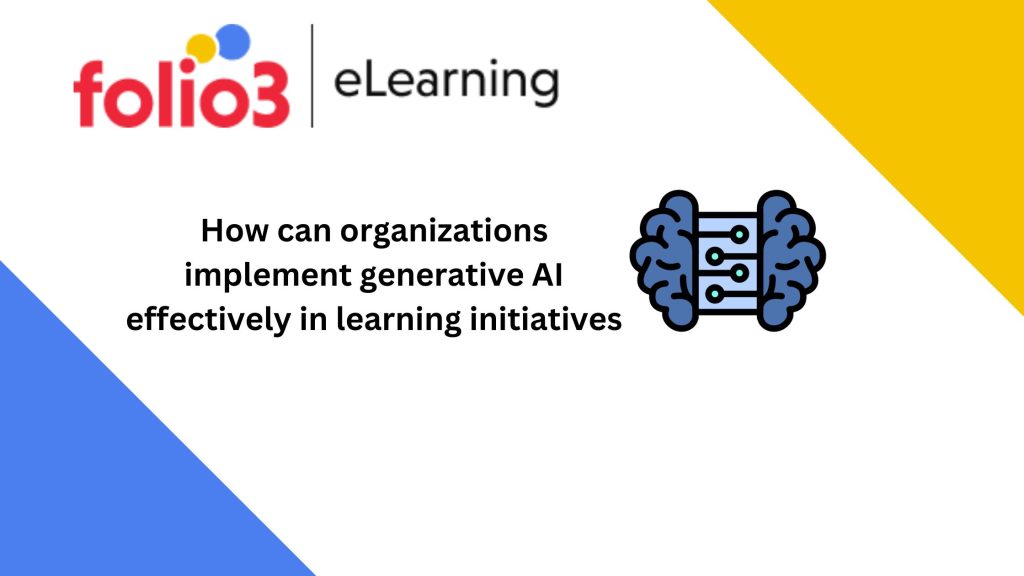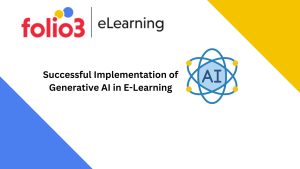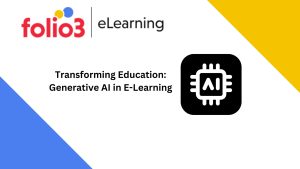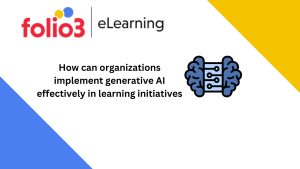
Executive Summary:
organizations implement generative AI effectively in learning initiatives in today’s rapidly changing digital ecosystem. With the use of this technology, eLearning experiences can be greatly improved, becoming more effective, and interesting.
Introduction:
Over the years, the field of eLearning has undergone a tremendous shift, partly thanks to developments in artificial intelligence (AI).
Among the different AI applications, generative AI has distinguished itself as a game-changer, enabling businesses to develop highly customized and engaging learning experiences.
Organizations may increase student engagement and get better results by successfully utilizing generative AI.
In order to accomplish these objectives, we will examine in this blog how businesses can implement generative AI effectively in learning initiatives.

Implementing Generative AI’s Potential in e-Learning
Organizations may create dynamic, personalized learning experiences that are suited to each learner’s needs by utilizing generative AI in eLearning.
- Creation and Personalization of Content:
The effects of generative AI on content creation and personalization are significant. Traditional eLearning materials frequently have static, homogenous information that might irritate and disengage learners.
However, generative AI adopts a learner-centric strategy by examining each learner’s unique facts, preferences, and development.
With the aid of this technology, businesses may produce individualized learning materials, such as books, articles, tests, or videos, that are catered to the specific requirements of each learner. An AI system, for instance, could recognize that a certain student excels in algebra but has trouble with calculus.
In order to help the learner better understand calculus ideas, it can then produce more practice problems and resources. This degree of personalization improves engagement while also hastening the learning process.
- Pathways for Adaptive Learning:
Adaptive learning routes in eLearning greatly benefit from AI. Fixed curricula are used in traditional eLearning courses, which frequently cause learners to lose interest. However, AI in eLearning continuously tracks student progress and instantly modifies the course material.
Organizations may provide learners with a dynamic, tailored learning experience by utilizing AI in eLearning. AI can move students on to more difficult material if they show mastery of a particular subject, minimizing boredom and ensuring that learning proceeds as intended.
The AI technology modifies the course content and sequencing in real time by continuously tracking learners’ progress and performance data.
- Natural Language Processing (NLP):
An important development of AI in eLearning is Natural Language Processing (NLP), which significantly alters how students interact with educational material. NLP innovations, in particular, allow for more immersive and active language acquisition.
In the context of AI in eLearning, chatbots and virtual assistants that use NLP to translate text in real-time and engage learners in realistic discussions help students learn new languages.
Language learning is made interesting and effective by these AI-driven language exchanges that mimic real-life situations. In a natural, interactive setting, learners may practice speaking and listening, get rapid feedback, and advance their language skills.
- Automated Assessment and Feedback Using AI in eLearning:
The application of AI in eLearning has completely changed assessment and feedback processes. The majority of traditional assessment methods rely on labor-intensive, subjective manual grading.
The assessment and feedback mechanisms powered by AI, however, successfully automate these processes. AI algorithms can assess homework, tests, and exams in eLearning according to predetermined standards.
Learners receive immediate, in-depth feedback highlighting their areas of strength and growth. This quick feedback loop is an effective motivator since it enables students to monitor their development and concentrate on areas where they need to do better.
Additionally, AI in eLearning makes it possible to analyze performance data across whole learner cohorts, helping instructors spot trends and potential course development areas and eventually improving the overall standard of the educational experience.
Best Practices for Effective Implementation of AI in eLearning
- Data Quality and Privacy:
Obtaining high-quality data is essential for successfully implementing AI in eLearning. AI algorithms are powered by clear, accurate, and pertinent data, which enables them to make wise judgments and offer insightful information.
Organizations should set up data gathering and storage procedures that protect the security and integrity of the data.
- Continuous Model Updates and Training:
To stay relevant in a developing eLearning environment, AI models need frequent training and upgrades. AI algorithms must update as new data becomes available and learning objectives shift.
Continuous training entails providing the AI system with new data and altering its parameters to match evolving learning objectives.
- User-Friendly Interfaces:
User friendliness must be taken into consideration while designing AI-driven eLearning elements.
It should be simple and natural for learners to interact with AI components. Simple interfaces with clear instructions and ease of use should cover up complex algorithms.
User-friendly interfaces improve the entire learning experience for students while also making managing AI-powered eLearning platforms easier for teachers and administrators.
- Feedback Mechanisms:
AI-driven eLearning systems should include feedback mechanisms to continuously enhance performance and usability. Encourage educators, administrators, and students to share their thoughts on using AI features.
Regular feedback can reveal problems, highlight potential improvement areas, and record user preferences. To improve user experiences, hone AI algorithms, and swiftly address any issues, organizations should actively collect and analyze this feedback.
5. Ethical Considerations:
Ethics should be taken into account while implementing AI in eLearning. Avoid creating biased AI systems that could reinforce unfair advantages or prejudice. Aim to make AI-driven judgments explicit and comprehensible, particularly when it comes to grading or assessment.





